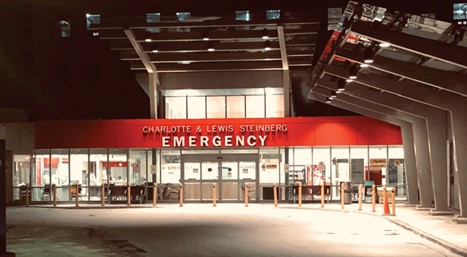NYGH’s emergency department research ‘leading the way’

In early 2020, with COVID-19 spreading and the demand for critical care rising, emergency departments (EDs) across Ontario prepared for the worst possible scenarios.
For the team at North York General’s Charlotte and Lewis Steinberg Emergency, this meant rapidly refining protocols and repurposing space for sick patients.
And for emergency physician Dr. Rohit Mohindra, the pandemic pivot meant refocusing the department’s research program.
“Adding research to the hospital’s pandemic response was an obvious and important next step,” says Dr. Mohindra.
Like most ED-based research, the aim of this research at NYGH is to evaluate emergency department care to find areas for improvement.
When Dr. Mohindra joined North York General’s emergency department in 2019 as the research lead, he wanted to advance NYGH’s ED research agenda. As one of the GTA’s busiest EDs serving one of the most diverse populations in the region, Charlotte and Lewis Steinberg Emergency is fertile ground for studying the impact of emergency medicine on health outcomes in the population.
With support of the Schwartz/Reisman Emergency Medicine Institute at Mount Sinai, where Dr. Mohindra also works as a clinician scientist, the McGill University-trained doctor embarked on studying the use digital tools to gain insights directly from patients of NYGH’s ED until the pandemic arrived, requiring him to shift gears overnight.
“To quickly acquire information about a new virus, we needed large hospitals that were likely to see many COVID patients to be part of the national COVID registry,” says Dr. Mohindra.
With 120,000 visits per year, NYGH’s emergency department was an ideal source of data for the Canadian COVID-19 Emergency Department Registry, an initiative of a pan-Canadian network of 50 emergency departments and public health partners. The network launched within weeks of Canada’s first case of COVID-19 to share information on how to manage sick patients with the new virus who were ending up in emergency rooms.
Having already put together a team of researchers and support staff, Dr. Mohindra and team were ready to make significant contributions to the registry. In fact, within two months of joining, North York General contributed 1,500 COVID-19 cases to the national registry.
Dr. Mohindra and team also set out to explore patient perspectives on the hospital’s telephone follow-up program for high-risk patients, working closely with Katie Dainty, PhD, Research Chair in Patient-Centred Outcomes at North York General.
The program targeted patients who presented to the emergency Department or the COVID-19 Assessment Centre (555 Finch Ave West) with multiple, coexisting medical conditions, those without access to follow-up care, highly symptomatic patients who but did not meet admission criteria, and other vulnerable populations.
Specifically, Dr. Mohindra and Dr. Dainty wanted to know if patients’ follow-up care needs were being met through the telephone program.
The study was awarded an Exploration Fund grant from the North York General Foundation’s Emergency Response Fund for the COVID-19 Pandemic and is currently in its final stages before publication.
Reflecting on the last 18 months, Dr. Paul Hannam, Chief of the Department of Emergency Medicine at North York General, praises Dr. Mohindra’s contributions.
“He is respected as a colleague, clinician scientist and person. He is able to incorporate complex ideas and make projects tangible, sustainable and doable, which has made all of the difference,” he says.
“Applying an analytic approach to the data we capture in our emergency department every day ensures we can evaluate our care and find new ways to improve,” Dr. Hannam adds.
“Dr. Mohindra and the entire NYGH emergency department are leading the way,” says Dr. Kevin Katz, clinician researcher and Medical Director of Infection Prevention and Control at North York General.
By applying practical, on-the-ground research like the work being led by Dr. Mohindra and his team, Dr. Katz says North York General is able to provide patients with “leading edge diagnostics and therapeutics” that can improve outcomes and lower health care costs.
“The attitude here is that doing research is new and challenging, but the overwhelming response is ‘how can we make this happen?’” says Dr. Mohindra, who has since collaborated with other departments such as surgery and cardiology on emergency research projects.
Dr. Mohindra also believes the pandemic has brought clinical research to the forefront while showing the reliance of the Canadian health care system on emergency departments.
“COVID has shown us how quickly we can get research launched while ensuring it is safe,” says Dr. Mohindra. “We always put patient care first, so looking for ways we can do it better is a natural extension of what we are already trying to do.”
